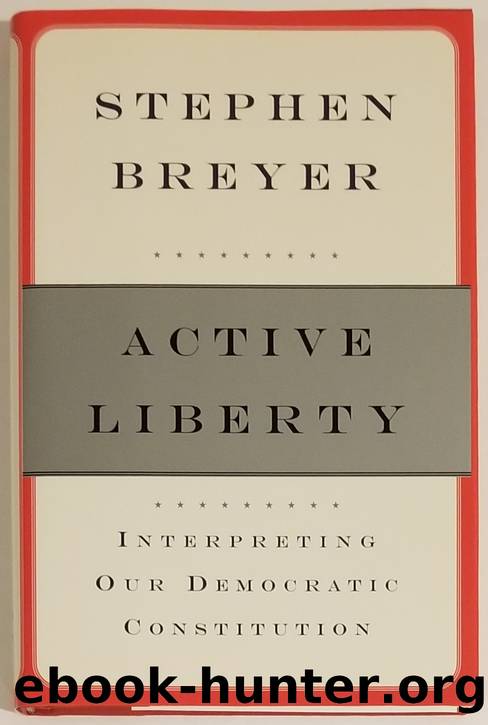Active Liberty: Interpreting Our Democratic Constitution by Stephen Breyer

Author:Stephen Breyer [Breyer, Stephen]
Language: eng
Format: epub
ISBN: 9780307424617
Google: HGxsl5rtSJ8C
Amazon: 1449864988
Published: 2007-12-18T16:25:36.332664+00:00
STATUTORY INTERPRETATION
The fifth example concerns statutory interpretation. It contrasts a literal text-based approach with an approach that places more emphasis on statutory purpose and congressional intent. It illustrates why judges should pay primary attention to a statuteâs purpose in difficult cases of interpretation in which language is not clear. It shows how overemphasis on text can lead courts astray, divorcing law from lifeâindeed, creating law that harms those whom Congress meant to help. And it explains why a purposive approach is more consistent with the framework for a âdelegated democracyâ that the Constitution creates.1
The interpretive problem arises when statutory language does not clearly answer the question of what the statute means or how it applies. Why does a statute contain such language? Perhaps Congress used inappropriate language. Perhaps it failed to use its own drafting expertise or failed to have committee hearings, writing legislation on the floor instead. Perhaps it chose politically symbolic language or ambiguous language over more precise languageâpossibilities that modern, highly partisan, interest-group-based politics (responding to overly simplified media accounts) make realistic. Perhaps no one in Congress thought about how the statute would apply in certain circumstances. Perhaps it is impossible to use language that foresees how a statute should apply in all relevant circumstances.
The founding generation of Americans understood these or similar possibilities. They realized that judges, though mere âfallible men,â would have to exercise judgment and discretion in applying newly codified law. But they expected that judges, when doing so, would remain faithful to the legislatorsâ will. The problem of statutory interpretation is how to meet that expectation.
Most judges start in the same way. They look first to the statuteâs language, its structure, and its history in an effort to determine the statuteâs purpose. They then use that purpose (along with the language, structure, and history) to determine the proper interpretation. Thus far, there is agreement. But when the problem is truly difficult, these factors without more may simply limit the universe of possible answers without clearly identifying a final choice. What then?
At this point judges tend to divide in their approach. Some look primarily to text, i.e., to language and text-related circumstances, for further enlightenment. They may try to tease further meaning from the language and structure of the statute itself. They may look to language-based canons of interpretation in the search for an âobjectiveâ key to the statuteâs proper interpretation, say a canon like noscitur a sociis, which tells a judge to interpret a word so that it has the same kind of meaning as its neighbors. Textualism, it has been argued, searches for âmeaning . . . in structure.â It means âpreferring the language and structure of the law whenever possible over its legislative history and imputed values.â It asks judges to avoid invocation of vague or broad statutory purposes and instead to consider such purposes at âlower levels of generality.â It hopes thereby to reduce the risk that judges will interpret statutes subjectively, substituting their own ideas of what is good for those of Congress.
Download
This site does not store any files on its server. We only index and link to content provided by other sites. Please contact the content providers to delete copyright contents if any and email us, we'll remove relevant links or contents immediately.
| Anthropology | Archaeology |
| Philosophy | Politics & Government |
| Social Sciences | Sociology |
| Women's Studies |
The Secret History by Donna Tartt(16623)
The Social Justice Warrior Handbook by Lisa De Pasquale(11489)
Thirteen Reasons Why by Jay Asher(7788)
This Is How You Lose Her by Junot Diaz(5772)
Weapons of Math Destruction by Cathy O'Neil(5037)
Zero to One by Peter Thiel(4824)
The Myth of the Strong Leader by Archie Brown(4789)
Promise Me, Dad by Joe Biden(4447)
Beartown by Fredrik Backman(4418)
Stone's Rules by Roger Stone(4415)
How Democracies Die by Steven Levitsky & Daniel Ziblatt(4398)
The Fire Next Time by James Baldwin(4342)
100 Deadly Skills by Clint Emerson(4077)
A Higher Loyalty: Truth, Lies, and Leadership by James Comey(4032)
Rise and Kill First by Ronen Bergman(4012)
The David Icke Guide to the Global Conspiracy (and how to end it) by David Icke(3881)
The Farm by Tom Rob Smith(3872)
Secrecy World by Jake Bernstein(3782)
The Doomsday Machine by Daniel Ellsberg(3731)
